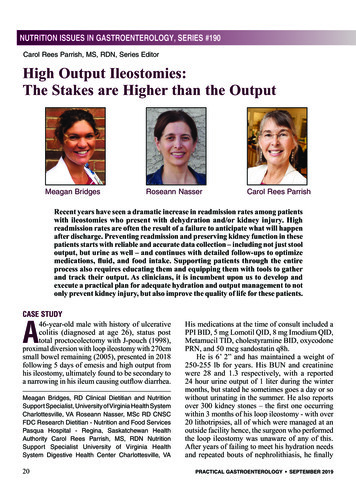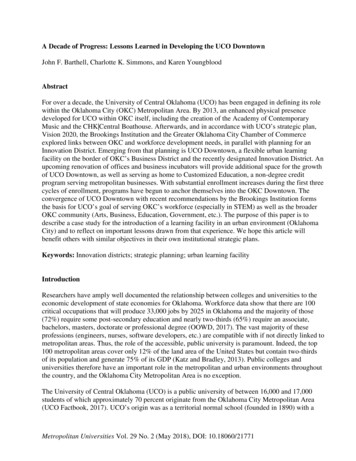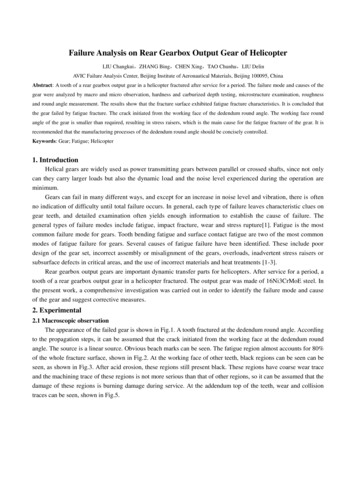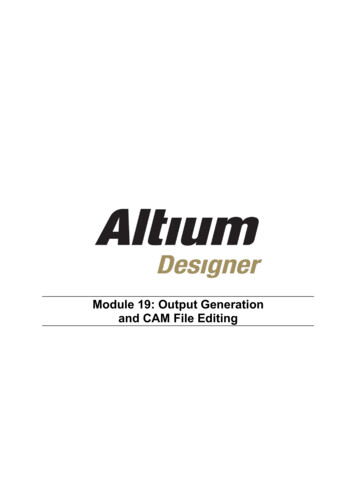
Transcription
Professional Aspects of Practice1.1 OpeningNotes:Copyright 2019. USF. College of Nursing. All rights reserved
Professional Aspects of PracticeObjectivesNotes:Professionalism has been defined as having or showing the skills, good judgement, andpolite behavior that is expected from a person who is trained to do a job well. Throughoutthis program you have developed an appreciation for how to utilize evidence to guide clinicalpractice and the decisions that you will be making on a daily basis. As you move forward andgain more clinical experience from mentors in the field, always remember to question whatyou are being taught, and use the literature to support their recommendations. If you everexperience a complication or poor outcome you will not be able to defend your actions byreferring to your training. The most recent evidence available in the literature and what themajority of providers in the field agree upon is most likely what you will be judged by. Thepresentation of a chronic pain patient is quite complex and it is often difficult to get twoproviders to agree on a single management strategy. So, it will be difficult as you start thisprocess. I am confident that you have developed a strong base of knowledge to grow from.You have completed courses in pain physiology/pathophysiology, pharmacology, andadvanced physical assessment. As far as your knowledge of interventional procedures, youinitiated learning with a review of what these procedures are, and then progressed to theadvantages/disadvantages of each procedure. You have an understanding of the potentialcomplications that could result from each procedure. You then learned about what to injectand what you should not inject. Finally, we then discussed how to perform these procedures.Becoming proficient in the the performance of these procedures will occur over time andwith good mentoring. You are armed with a great deal of knowledge, now it is time to moveforward and become a leader in the field.Copyright 2019. USF. College of Nursing. All rights reserved
Professional Aspects of PracticeDocumentationNotes:Documentation assists health care professionals in providing appropriate services to patientsby documenting indications and medical necessity. It is a reflection of the competency andcharacter of the health care provider. Proper documentation is considered a cornerstone ofthe quality of patient care. When providing care for a patient with pain, the documentationmust be accurate, complete, and reflect all of the services that were provided during thepatient encounter. Documentation requirements include an appropriate medical record,utilizing recognized and acceptable standards of documentation, and an established process.The patient’s record should include the results of the patient assessment and evaluation. Inaddition, the diagnosis with supporting documentation, diagnostic testing, laboratory, andimaging results should be present. Documentation should also include the patient specifictreatment plan, goals and objectives with proper documentation of informed consent for anyprocedures performed.Copyright 2019. USF. College of Nursing. All rights reserved
Professional Aspects of PracticeDocumentation StandardsNotes:There are simple but yet extremely important standards of documentation that must befollowed. All entries must be dated with month, day, and year. A summary sheet should haveidentifying information, height, weight, medication list, previous surgeries, and diagnosis.Every page in the chart should be patient identified. All telephone calls must be documented.Documentation of all health risk factors including allergies and adverse reactions tomedications, food, and other substances should be included.Copyright 2019. USF. College of Nursing. All rights reserved
Professional Aspects of PracticeMedical NecessityNotes:In order to establish medical necessity appropriate diagnosis and coding from theInternational Classification of Diseases 10th revision, clinical modification better known asthe ICD-10-CM must be submitted to third party payers. This information is submitted toprivate and government medical insurance agencies in order to justify services rendered andindicate the severity of the patients condition. The balanced budget act (HR 2015,section4317) requires that all health care providers submit diagnostic information for allMedicare/Medicaid patients. Health care providers are required to code by listing the ICD-10CM diagnostic codes shown in the medical record to be chiefly responsible for the servicesprovided. The centers for medicare and medicaid services defines medical necessity in theseterms: No payment may be made under part A or part B for any expense incurred for itemsor services which are not reasonable and necessary for the diagnosis or treatment of illnessor injury, or to improve the functioning of a participant. At least one publication has definedmedical necessity as “ the shortest least expensive, or least intense level of treatment, care orservice rendered, or supply provided, as determined to the extent required to diagnose ortreat an injury or sickness.Copyright 2019. USF. College of Nursing. All rights reserved
Professional Aspects of PracticeGeneral RequirementsNotes:Most insurers will have general requirements with regard to proper documentation andestablishing medical necessity. The procedure assessment should include individual patientresponses. The documentation of the procedure should include whether or not the block wasdiagnostic or therapeutic. There should be a both a pre-procedural evaluation and a postprocedural evaluation. The patients subjective response to include the current pain level andthe ability to perform previously painful maneuvers. Documentation regarding the amount ofpain relief from the procedure is critical. The pain relief should be greater than or equal to80-90 percent improvement when performing prior painful maneuvers and with persistentpain relief. The six week evaluation should demonstrate the ability to perform previouslypainful maneuvers with persistent pain relief greater than or equal to 50 percent from thebaseline assessment. The procedure should be performed under fluoroscopy or CT.Copyright 2019. USF. College of Nursing. All rights reserved
Professional Aspects of PracticeEpidural Steroid InjectionsNotes:Centers for medicare and medicaid services evaluation and documentation requirements forepidural steroid injection generally include:A complete initial evaluation with a history and physical. A physiologic and functionalassessment as feasible with a description of indication and medical necessity. The suspectedorganic problem, a moderate to severe pain disability, no evidence of contraindications tothe performance of the procedure, non-responsiveness to prior interventions with animprovement in physical status for repeat blocks or other interventions, Repeat ofintervention only with a return of pain and deterioration of functional status. In the diagnosisphase the epidural steroid injection should be no sooner than one week but two weeks ispreferred. If a negative result occurs no more injections unless new clinical signs andsymptoms develop. Consider accumulative steroid doses to limit complications.Copyright 2019. USF. College of Nursing. All rights reserved
Professional Aspects of PracticeFacet InjectionsNotes:Centers for medicare and medicaid services evaluation and documentation requirements forfacet injection generally include: specific documentation which substantiates the suspecteddiagnosis, demonstration of a lack of success with medical management prior to injection. Apositive response is an initial pain relief of 80-90 percent and the ability to perform priorpainful maneuvers. Of note, the routine performance of both diagnostic and therapeuticblocks to both cervicothoracic and lumbosacral regions may prompt a medical review. Also,at least one insurer does not recommend facet blocks as a diagnostic procedure forradiofrequency ablation in patients with: neurological deficits, more than one pain syndrome,definitive clinical and imaging findings, fusion surgery at suspected levels, and knownetiology of spine pain: to include facet osteoarthritis, and degenerative disc disease.Copyright 2019. USF. College of Nursing. All rights reserved
Professional Aspects of PracticeTrigger Point InjectionsNotes:Centers for medicare and medicaid services evaluation and documentation requirements fortrigger point injections generally include: the evaluation should contain relevant medicalhistory, physical exam, tests and procedure results. The documentation should describe theevaluation which lead to the diagnosis identification of the affected muscle, reason forselection of a trigger point injection as a treatment, to include if this is the initial treatment ora subsequent treatment. The utilization guidelines will allow for normally only 3 injections ofthe same trigger point. The medical record must clearly indicate necessity. Some insures willrequire documentation that conservative therapies have been tried and were not successful.Conservative treatments may consist of bed rest, exercises, heating/cooling modalities,massage. Medications such as Non-steroidal anti-inflammatories muscle relaxants and nonopioid analgesics. Some insurers will require that the symptoms have been present for 3months or longer in duration.Copyright 2019. USF. College of Nursing. All rights reserved
Professional Aspects of PracticeMost Commonly Performed ProceduresNotes:It is crucial to develop a strategy with identification of the most commonly performedprocedures and their related ICD-10-CM codes. The frequency of the performance of specificinterventional techniques over a 13 year period was published in a 2016 issue of PainPhysician. The report was based on an analysis of the medicare population from 2000 to2013. Spinal procedures accounted for over 90% of the procedures and other types of nerveblocks accounted for 9%, disc procedures including disc decompression accounted for lessthan 1%. The 90% of spinal procedures included epidural procedures at 46% and facet jointinterventions/sacroiliac joint blocks at 44%. The report goes on to display a listing of the 20most commonly performed interventional procedures which constitutes 95% of the totalvolume of Interventional pain management procedures. These procedures include: Caudalepidural injections, Lumbar interlaminar epidural injections, lumbar/sacral transforaminalepidural injections, cervical epidural injections, thoracic epidural injections, percutaneousepidural adhesiolysis, lumbar/sacral facet joint injections and nerve blocks, cervical facetjoint injections and nerve blocks, thoracic facet joint injections and nerve blocks,lumbar/sacral facet joint nerve radiofrequency neurolysis, cervical medial branchradiofrequency neurolysis, thoracic medial branch radiofrequency neurolysis, sacroiliac jointinjections, cervical sympathetic nerve blocks, lumbar paravertebral sympathetic blocks,hypogastric plexus blocks, celiac plexus blocks, lumbar discography, intercostal nerve blocks,and spinal cord stimulation. These are not described in the order of utilization.Copyright 2019. USF. College of Nursing. All rights reserved
Professional Aspects of PracticeAANA Pain GuidelinesNotes:The American Association of Nurse Anesthetists has developed Chronic Pain ManagementGuidelines. The purpose of these guidelines is to promote safe and effective chronic painmanagement. The chronic pain management guidelines are intended to promote high-qualitycare and do not assure specific outcomes. The guidelines were developed using an evidencebased literature review process, AANA pain management scope of practice membershipsurvey, ongoing consultation with the AANA Practice committee, and the pain managementwork team. The pain management work team is composed of Certified Registered NurseAnesthetist pain management experts and an open comment survey of a sample of AANAmembers. These guidelines have been attached as a PDF document for your review.Copyright 2019. USF. College of Nursing. All rights reserved
Professional Aspects of PracticeGovernment Accountability OfficeNotes:The government accountability office performed a review of Medicare’s payment policyregarding the provision of chronic pain management services provided by CRNA’s. Thedocument was published in 2014 and examined trends in medicare provider billing forselected chronic pain procedures. It also determined the extent to which billing for chronicpain procedures changed during a period of time in which a specific medicare administrativecontractor denied payment to CRNA’s. It identified states in which medicare administrativecontractors allowed payment to CRNA’s for selected chronic pain procedures. Finally itreviewed how medicare administrative contractors implemented the payment policyregarding CRNA rendered services over a specific period of time. This document is includedin your resources and is critical for you to review.Copyright 2019. USF. College of Nursing. All rights reserved
Professional Aspects of PracticeConclusionNotes:Throughout the advanced pain management education curriculum you have been presentedwith many challenges. As you move forward in your career remember to use the researchand evidence to guide your practice. Make good decisions and seek out expert mentors. Yourare among few in the nurse anesthesia profession who have this knowledge. You should beproud of what you have accomplished and where you are headed. Be a leader for ourprofession.ReferencesCopyright 2019. USF. College of Nursing. All rights reserved
Professional Aspects of PracticeEnd of PresentationCopyright 2019. USF. College of Nursing. All rights reserved
work team. The pain management work team is composed of Certified Registered Nurse Anesthetist pain management experts and an open comment survey of a sample of AANA members. These guideli











